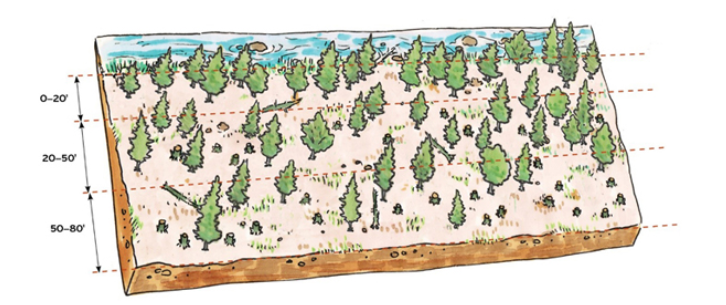New year, new Oregon forest protection laws
January 22, 2021
Sustainability is at the core of Oregon’s laws regarding forest practices and land use planning. The forest practices laws, which are enforced by the Oregon Department of Forestry (ODF), require state and private forest landowners to protect soil, air, water and wildlife habitat for future generations. Since the Oregon Forest Practices Act became law in 1971, the Oregon Board of Forestry has regularly updated its rules to keep them current and responsive to evolving scientific knowledge and public concerns.
Occasionally, the Oregon Legislature has amended the Forest Practices Act to include specific requirements for forest operations. This was the case when the Legislature passed Senate Bill 1602 in July 2020. The new law changed certain parts of the Forest Practices Act, and two of those changes went into effect at the beginning of this year. The first change increases the size of buffers around homes, schools, water intakes and some streams that helicopters applying herbicides must avoid. The second expands a requirement that restricts logging near streams that provide habitat for certain fish species. You can read the full text of Senate Bill 1602 here.
Helicopter herbicide spray buffers
Starting Jan. 1, 2021, the Forest Practices Act mandates that helicopters spraying herbicides on forestland must leave wider buffers around school properties, dwellings and streams. A buffer is an area adjacent to a stream, school, inhabited dwelling or water intake that contains a combination of trees, shrubs, and/or other perennial plants. Trees within certain buffer zones cannot be harvested.
Under the new rules, the size of the required buffers are:
• At least 75 feet from streams with fish or domestic use
• 50 feet from other streams with surface water present
• 300 feet from a school or inhabited dwelling
• 300 feet from a qualifying water intake
Stream buffer rules expanded
A relatively new Forest Practices Act rule requiring wider buffers of trees be left unharvested around salmon, steelhead and bull trout streams now includes the Siskiyou region in southern Oregon. Previously this rule, which requires tree buffers of varying depth depending on the size of the stream inhabited by salmon, steelhead or bull trout, applied to lands west of the Cascades with the exception of the Siskiyou region.
The Board of Forestry created the salmon, steelhead and bull trout (SSBT) streams rules in 2017 to prevent an increase in stream temperature, which can negatively impact salmon, steelhead and bull trout. Not enough science was known at that time about the Siskiyou region to apply these wider buffers, also known as a Riparian Management Area (RMA).
This graphic from the OFRI publication Oregon’s Forest Protection Laws: An Illustrated Manual shows the newly revised requirement to leave a wider buffer of trees on either side of a medium-size SSBT stream in the Siskiyou region.

There are several required zones in the SSBT stream buffer, where varying degrees of timber harvest are allowed. For example, in a medium-size stream designated as an SSBT, all the trees in a “no-harvest zone,” located 0 to 20 feet from the stream’s high-water level, must be left. In the “inner zone,” located 20 to 50 feet from the high-water level, and the “outer zone,” located 50 to 80 feet from the high-water level, some trees can be harvested. Compared to a non-SSBT fish stream, the RMA is 10 feet wider, and the trees that are left unharvested need to be split between the inner and outer zone.
More information about SSBT rules can be found in Oregon’s Forest Protection Laws: An Illustrated Manual. ODF also offers informational videos about these laws. Watch the videos here.
Additional rule changes
Additional changes to the Forest Practices Act outlined in Senate Bill 1602 will become effective between July 2021 and June 2022. This includes a mandate that ODF develop an e-notification system for helicopter herbicide application to improve communication among landowners, helicopter operators, neighbors and water users. Before they spray, helicopter herbicide applicators must notify water users and neighbors who have signed up to receive notices through this system and are within one mile of the proposed work. The law provides funds for developing this new system. It will likely take about a year to complete.
Learn more about Oregon’s forest protection laws
With more than 250 enforceable rules that apply to state and private forestland, there’s a lot to take in when it comes to the Oregon Forest Practices Act. That’s why OFRI created Oregon’s Forest Protection Laws: An Illustrated Manual, currently in its third edition, as a reference for Oregon’s forest landowners to following these important state rules and best management practices aimed at protecting natural resources. You can order the manual or download it for free from the publications section of our website, OregonForests.org.
Oregon forest landowners can find additional information and resources on the state’s forest protection laws on the Partnership for Forestry Education website, KnowYourForest.org. ODF also has information on each section of the Forest Practices Act and additional videos on their website.
ODF stewardship foresters, who provide technical assistance and enforcement to ensure the state’s forest protection laws are followed, are another great resource; they’re available to contact in every corner of Oregon.
From the woods,
Julie Woodward
Senior Manager, Forestry Education
